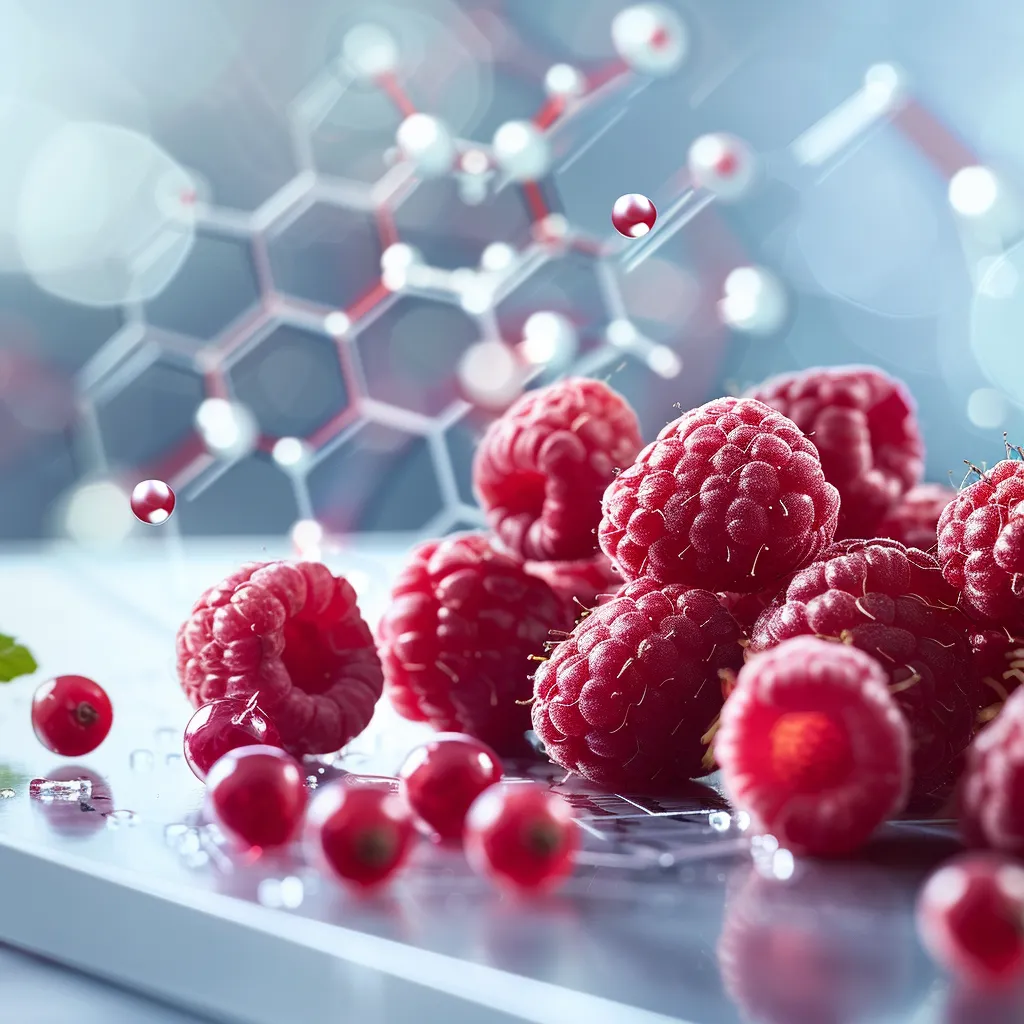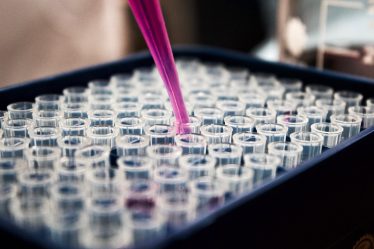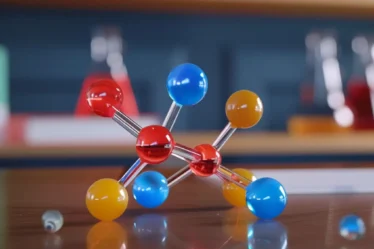
Did you know ketones are in nail polish remover? You can also find ketones in fruits such as raspberries, where they carry an intoxicating smell and taste.
Acetone, the main ingredient in nail polish remover, is the simplest ketone. Ketones are found in many everyday products, such as solvents, perfumes, and polymers. They are also present in our bodies as ketone bodies, formed when fats are broken down in the liver.
Ketones: Quick Summary
Do you just need the basics? Here’s a simple explanation of what is a ketone:
🟠 Ketones are organic compounds with a carbonyl group ($\mathrm{C=O}$) bonded to two carbon atoms within a carbon chain.
🟠 Acetone (also known as propanone) is the simplest ketone, having the formula $\mathrm{CH_3{-}C(=O){-}CH_3}$.
🟠 Due to the polarity of the carbonyl group, ketones undergo nucleophilic addition reactions with various nucleophiles.
Struggling with acetone, propanone, hexane-3-one, and other ketones? Don’t worry. A tutor can explain it in a way that clicks for you. You can find more useful topics in our Chemistry blogs.
What Are Ketones?
Ketones are organic compounds featuring a carbonyl group ($\mathrm{C=O}$) bonded to two carbon atoms within a carbon chain. This structure sets them apart from other carbonyl-containing compounds. Ketones have diverse forms and are present in various chemical substances.
The general formula for a ketone is $\mathrm{R{-}C(=O){-}R’}$, where $\mathrm{R}$ and $\mathrm{R’}$ are hydrocarbon groups, either alkyl or aryl.
Ketone examples
- Acetone (propanone): $\mathrm{CH_3{-}C(=O){-}CH_3}$, where both $\mathrm{R}$ and $\mathrm{R’}$ are methyl groups ($\mathrm{CH_3}$).
- Hexan-3-one: $\mathrm{CH_3CH_2CH_2{-}C(=O){-}CH_2CH_3}$, where the carbonyl group is on the third carbon of a six-carbon chain.
Unlike aldehydes, which have at least one hydrogen atom attached to the carbonyl carbon, ketones have the carbonyl group bonded to two carbon atoms. This internal placement within the carbon chain influences their chemical behavior and reactions.
The Structure of Ketones and the Carbonyl Group
Studying the structure of ketones helps explain their properties and reactions. The carbonyl group ($\mathrm{C=O}$) is central to this understanding. In ketones, the carbonyl carbon connects to two other carbon atoms from hydrocarbon groups ($\mathrm{R}$ and $\mathrm{R’}$), distinguishing them from aldehydes.
The double bond between carbon and oxygen is polar because oxygen is more electronegative than carbon. This creates a partial negative charge on oxygen and a partial positive charge on carbon, affecting how ketones interact with other molecules.
For instance, in acetone, the polarity of the carbonyl group influences its solubility in water and reactivity with other substances.
Molecular Geometry and Hybridization in Ketones
The carbonyl carbon in ketones has a trigonal planar shape with bond angles of about $120^\circ$. It uses $\mathrm{sp^2}$ hybridization, combining one s orbital and two p orbitals to create three hybrid orbitals.
The double bond consists of one sigma ($\sigma$) bond, formed by the overlap of $\mathrm{sp^2}$ hybrid orbitals, and one pi ($\pi$) bond, formed by the overlap of unhybridized p orbitals on carbon and oxygen.
This structure allows reagents to approach the carbonyl carbon from either side, making ketones reactive toward nucleophiles.
Naming Ketones: From Propanone to Hexan-3-one
Learning how to name ketones helps identify their structures and properties. Ketones have specific naming conventions set by the International Union of Pure and Applied Chemistry (IUPAC) and common names used in everyday contexts.
IUPAC Naming Rules for Ketones
The IUPAC system provides a systematic way to name ketones based on their structures. Here are the steps to name a ketone using IUPAC rules:
- Identify the longest carbon chain containing the carbonyl group: This chain determines the parent name.
- Number the carbon atoms: Start from the end nearest to the carbonyl group to give it the lowest possible number.
- Replace the ‘-e’ ending with ‘-one’: Indicate a ketone by changing the suffix.
- Indicate the position of the carbonyl group: Insert the number corresponding to its position before the parent name or suffix.
IUPAC Naming Ketones Example
Propanone ($\mathrm{CH_3{-}C(=O){-}CH_3}$):
The longest chain has three carbon atoms. The carbonyl group is on the second carbon. Since it can only be on the second carbon in propanone, we don’t need to specify the number.
IUPAC Name: Propanone.
Hexan-3-one ($\mathrm{CH_3CH_2CH_2{-}C(=O){-}CH_2CH_3}$):
The longest chain has six carbon atoms. Numbering from the end closest to the carbonyl group places it on carbon 3.
IUPAC Name: Hexan-3-one.
Butanone ($\mathrm{CH_3CH_2{-}C(=O){-}CH_3}$):
A four-carbon chain with the carbonyl group on the second carbon.
IUPAC Name: Butan-2-one.
Common Names of Ketones, Including Acetone
Common names are still widely used for simpler ketones:
- Name each alkyl group attached to the carbonyl carbon: Identify the two alkyl groups.
- List the alkyl groups alphabetically. Arrange the names accordingly.
- Add the word ‘ketone’: Place it after the alkyl group names.
Common Names Ketones Example
Acetone ($\mathrm{CH_3{-}C(=O){-}CH_3}$):
Both alkyl groups are methyl groups. The common name is dimethyl ketone, but it’s almost always called Acetone.
Methyl Ethyl Ketone (MEK) ($\mathrm{CH_3CH_2{-}C(=O){-}CH_3}$):
Alkyl groups are methyl and ethyl. Common name: Ethyl methyl ketone.
Physical Properties of Ketones
Exploring the physical properties of ketones explains how they behave in different environments. Their polarity, solubility, and boiling and melting points are important for predicting reactions and understanding their uses.
Polarity and Solubility of Ketones
Ketones are polar molecules due to the carbonyl group. The oxygen atom’s higher electronegativity creates a partial negative charge on oxygen and a partial positive charge on carbon.
Solubility of Ketones in Water:
- Small Ketones: Ketones like acetone are highly soluble in water because they can form hydrogen bonds with water molecules.
- Larger Ketones: As the hydrocarbon chain length increases, solubility in water decreases due to the nonpolar hydrocarbon part dominating.
Ketones are also good solvents for organic compounds because they dissolve polar and nonpolar substances.
Example:
- Acetone (Propanone): Completely miscible with water.
- Hexan-3-one: Moderately soluble in water due to a longer carbon chain.
Boiling and Melting Points of Ketones
Ketones generally have higher boiling points than alkanes of similar size but lower boiling points than alcohols.
Factors Affecting Boiling Points:
- Dipole-Dipole Interactions: The polar carbonyl groups lead to attractions between molecules, increasing boiling points.
- Molecular Size: Larger ketones have higher boiling points due to increased van der Waals forces.
Comparison Table Propanone
| Compound | Molecular Weight (g/mol) | Boiling Point (°C) |
| Propane | 44 | -42 |
| Propanone | 58 | 56 |
| Propanol | 60 | 97 |
Propane is a nonpolar alkane with a very low boiling point. Propanone (Acetone) has a higher boiling point due to its polar carbonyl group. Propanol has the highest boiling point because alcohols can form hydrogen bonds with each other.
Melting Points:
Ketones have moderate melting points that increase with molecular weight. They generally have lower melting points than corresponding alcohols because ketones cannot form hydrogen bonds with themselves.
Chemical Reactions Involving Ketones
Ketones undergo various chemical reactions because of the reactivity of their carbonyl group ($\mathrm{C=O}$), including nucleophilic addition and reduction. Unlike aldehydes, ketones are generally resistant to oxidation under mild conditions.
Nucleophilic Addition Reactions with Ketones
In nucleophilic addition reactions, a nucleophile attacks the electrophilic carbonyl carbon of a ketone. The partial positive charge on the carbonyl carbon attracts nucleophiles, which donate an electron pair to form a new bond. Nucleophilic addition converts the ketone into an alcohol.
Nucleophilic Addition Ketones
Attack by Nucleophile: The nucleophile approaches the carbonyl carbon and forms a bond by donating an electron pair.
Formation of Alkoxide Ion: The electrons from the carbon-oxygen double bond shift to the oxygen atom, giving it a negative charge.
Protonation: The negatively charged oxygen atom gains a proton (usually from the solvent), forming a hydroxyl group.
Common Nucleophiles that React with Ketones
Here are some nucleophiles that commonly react with ketones:
Hydride Ions ($\mathrm{H^-}$): Derived from reducing agents like sodium borohydride ($\mathrm{NaBH_4}$) or lithium aluminum hydride ($\mathrm{LiAlH_4}$). They reduce ketones to secondary alcohols.
$$\mathrm{R{-}C(=O){-}R’} + \mathrm{H^-} \rightarrow \mathrm{R{-}CH(OH){-}R’}$$
Grignard Reagents ($\mathrm{RMgX}$): Organomagnesium compounds that add alkyl groups to ketones, forming tertiary alcohols after protonation.
$$\mathrm{R{-}C(=O){-}R’} + \mathrm{RMgX} \rightarrow \mathrm{R{-}C(R)(OMgX){-}R’} \xrightarrow{\text{H}_2\text{O}} \mathrm{R{-}C(R)(OH){-}R’}$$
Cyanide Ions ($\mathrm{CN^-}$): React with ketones to form cyanohydrins with a hydroxyl and a cyanide group attached to the same carbon.
$$\mathrm{R{-}C(=O){-}R’} + \mathrm{CN^-} \rightarrow \mathrm{R{-}C(CN)(OH){-}R’}$$
Reduction of Ketones
You can reduce ketones to secondary alcohols using reducing agents. This process adds hydrogen to the carbonyl group.
Common reducing agents:
- Sodium Borohydride ($\mathrm{NaBH_4}$): Suitable for ketones and aldehydes.
- Lithium Aluminum Hydride ($\mathrm{LiAlH_4}$): A stronger reducing agent that reduces esters and carboxylic acids.
- Catalytic Hydrogenation: Uses hydrogen gas ($\mathrm{H_2}$) with a metal catalyst like palladium or platinum.
Reaction of ketone reduction:
$$\mathrm{R{-}C(=O){-}R’} + \mathrm{2H} \rightarrow \mathrm{R{-}CH(OH){-}R’}$$
Oxidation of Ketones
Ketones are generally oxid-resistant because they lack a hydrogen atom on the carbonyl carbon. However, strong oxidizing agents can cleave the carbon-carbon bonds adjacent to the carbonyl group, breaking the molecule into smaller pieces.
Strong oxidizing agents:
- Potassium Permanganate ($\mathrm{KMnO_4}$): Can oxidize ketones under vigorous conditions.
- Ozone ($\mathrm{O_3}$): Used in ozonolysis to cleave carbon-carbon bonds.
Reaction of ketone oxidation:
$$\mathrm{R{-}C(=O){-}R’} + [\mathrm{O}] \rightarrow \mathrm{R{-}COOH} + \mathrm{R'{-}COOH}$$
Keto-Enol Tautomerism in Ketones
Ketones can exist in two interconvertible tautomers: the keto and enol forms. This phenomenon is known as keto-enol tautomerism.
- Keto Form: The typical structure of a ketone with a carbonyl group.
- Enol Form: Formed when a hydrogen atom from the alpha carbon shifts to the oxygen atom, creating an alkene and an alcohol group.
Equilibrium Between Forms
$$\mathrm{R{-}C(=O){-}CH_2{-}R’} \leftrightarrow \mathrm{R{-}C(OH){=}CH{-}R’}$$
Although the keto form is more stable, the enol form can participate in unique reactions, such as halogenation at the alpha position. Acids or bases can catalyze the interconversion between these forms.
Example of Keto-Enol Tautomerism
In acidic conditions, propanone (acetone) can tautomerize to its enol form:
$$\mathrm{CH_3{-}C(=O){-}CH_3} \leftrightarrow \mathrm{CH_3{-}C(OH){=}CH_2}$$
While the keto form is more stable, the small amount of enol form present can significantly impact certain reactions.
Advance Your Knowledge of Ketones
Are ketones, such as acetone and propanone, tricky for you? A qualified chemistry instructor can explain complex topics in a way that makes sense to you, making organic and inorganic chemistry understandable and enjoyable.
Search for a tutor using phrases like “chemistry tutor Edinburgh” or “chemistry teacher Liverpool” on platforms like meet’n’learn. You’ll find someone who can tailor lessons to your needs.
If you prefer learning in a group, search for “chemistry classes Leeds” or “chemistry lessons London” online. The search will lead you to chemistry tutoring nearby.
Ketones: Frequently Asked Questions
1. What are ketones in organic chemistry?
Ketones are organic compounds with a carbonyl group ($\mathrm{C=O}$) bonded to two carbon atoms.
2. How do ketones differ from aldehydes?
Ketones have a carbonyl group attached to two carbon atoms, while aldehydes are attached to one carbon and one hydrogen atom.
3. What is the simplest ketone and its formula?
The simplest ketone is acetone (propanone), with the chemical formula $\mathrm{CH_3{-}C(=O){-}CH_3}$.
4. How are ketones named using IUPAC rules?
Ketones are named by replacing the ‘-e’ ending of the parent alkane with ‘-one’ and indicating the position of the carbonyl group.
5. Can ketones form hydrogen bonds with water?
Yes, ketones can form hydrogen bonds with water because of their polar carbonyl group, making small ketones soluble in water.
6. What reactions do ketones undergo in nucleophilic addition?
Ketones undergo nucleophilic addition reactions where nucleophiles attack the carbonyl carbon, forming alcohols.
7. How can ketones be made from secondary alcohols?
Ketones can be made by oxidizing secondary alcohols using oxidizing agents like potassium dichromate.
8. What is keto-enol tautomerism in ketones?
Keto-enol tautomerism is the balance between the keto form and the enol form (with a double bond and alcohol group) of a ketone.
Sources:
1. ThoughtCo
2. Britannica
3. Wikipedia



